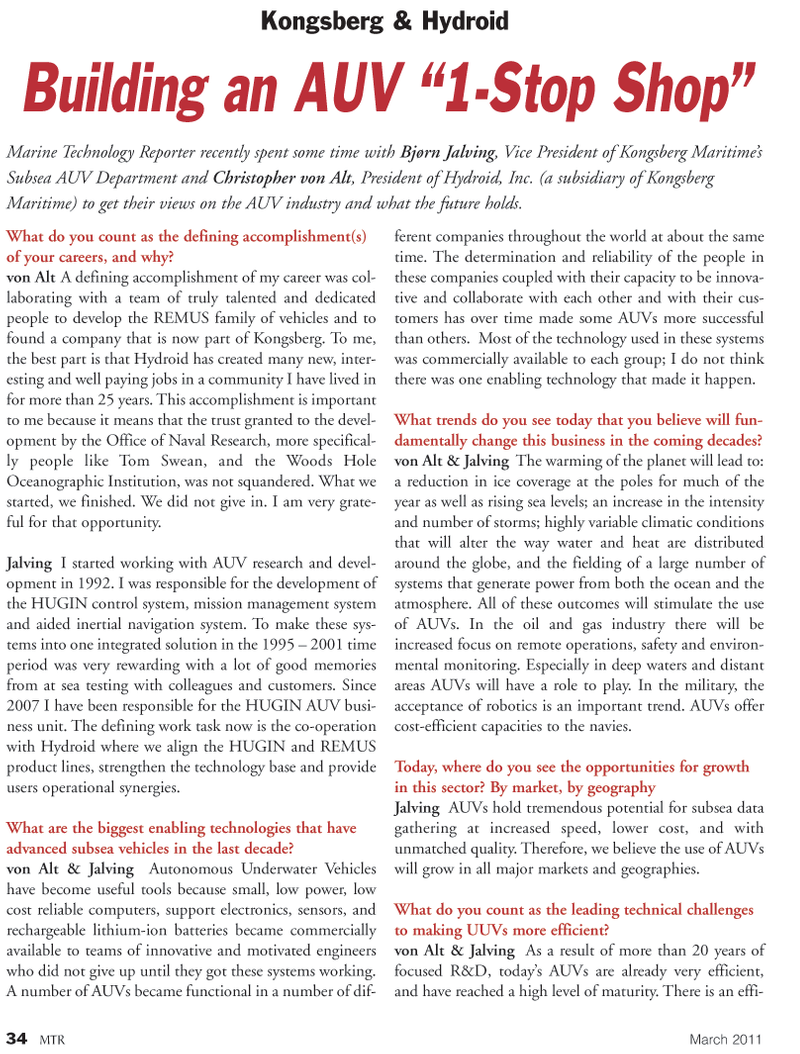
Page 34: of Marine Technology Magazine (March 2011)
Subsea Vehicles: AUV, ROV, UUV Annual
Read this page in Pdf, Flash or Html5 edition of March 2011 Marine Technology Magazine
What do you count as the defining accomplishment(s) of your careers, and why? von Alt A defining accomplishment of my career was col- laborating with a team of truly talented and dedicated people to develop the REMUS family of vehicles and to found a company that is now part of Kongsberg. To me, the best part is that Hydroid has created many new, inter- esting and well paying jobs in a community I have lived in for more than 25 years. This accomplishment is important to me because it means that the trust granted to the devel- opment by the Office of Naval Research, more specifical- ly people like Tom Swean, and the Woods Hole
Oceanographic Institution, was not squandered. What we started, we finished. We did not give in. I am very grate- ful for that opportunity.
Jalving I started working with AUV research and devel- opment in 1992. I was responsible for the development of the HUGIN control system, mission management system and aided inertial navigation system. To make these sys- tems into one integrated solution in the 1995 – 2001 time period was very rewarding with a lot of good memories from at sea testing with colleagues and customers. Since 2007 I have been responsible for the HUGIN AUV busi- ness unit. The defining work task now is the co-operation with Hydroid where we align the HUGIN and REMUS product lines, strengthen the technology base and provide users operational synergies.
What are the biggest enabling technologies that have advanced subsea vehicles in the last decade? von Alt & Jalving Autonomous Underwater Vehicles have become useful tools because small, low power, low cost reliable computers, support electronics, sensors, and rechargeable lithium-ion batteries became commercially available to teams of innovative and motivated engineers who did not give up until they got these systems working.
A number of AUVs became functional in a number of dif- ferent companies throughout the world at about the same time. The determination and reliability of the people in these companies coupled with their capacity to be innova- tive and collaborate with each other and with their cus- tomers has over time made some AUVs more successful than others. Most of the technology used in these systems was commercially available to each group; I do not think there was one enabling technology that made it happen.
What trends do you see today that you believe will fun- damentally change this business in the coming decades? von Alt & Jalving The warming of the planet will lead to: a reduction in ice coverage at the poles for much of the year as well as rising sea levels; an increase in the intensity and number of storms; highly variable climatic conditions that will alter the way water and heat are distributed around the globe, and the fielding of a large number of systems that generate power from both the ocean and the atmosphere. All of these outcomes will stimulate the use of AUVs. In the oil and gas industry there will be increased focus on remote operations, safety and environ- mental monitoring. Especially in deep waters and distant areas AUVs will have a role to play. In the military, the acceptance of robotics is an important trend. AUVs offer cost-efficient capacities to the navies.
Today, where do you see the opportunities for growth in this sector? By market, by geography
Jalving AUVs hold tremendous potential for subsea data gathering at increased speed, lower cost, and with unmatched quality. Therefore, we believe the use of AUVs will grow in all major markets and geographies.
What do you count as the leading technical challenges to making UUVs more efficient? von Alt & Jalving As a result of more than 20 years of focused R&D, today’s AUVs are already very efficient, and have reached a high level of maturity. There is an effi-
Kongsberg & Hydroid
Building an AUV “1-Stop Shop”
Marine Technology Reporter recently spent some time with Bjørn Jalving, Vice President of Kongsberg Maritime’s
Subsea AUV Department and Christopher von Alt, President of Hydroid, Inc. (a subsidiary of Kongsberg
Maritime) to get their views on the AUV industry and what the future holds. 34 MTR March 2011

 33
33

 35
35
